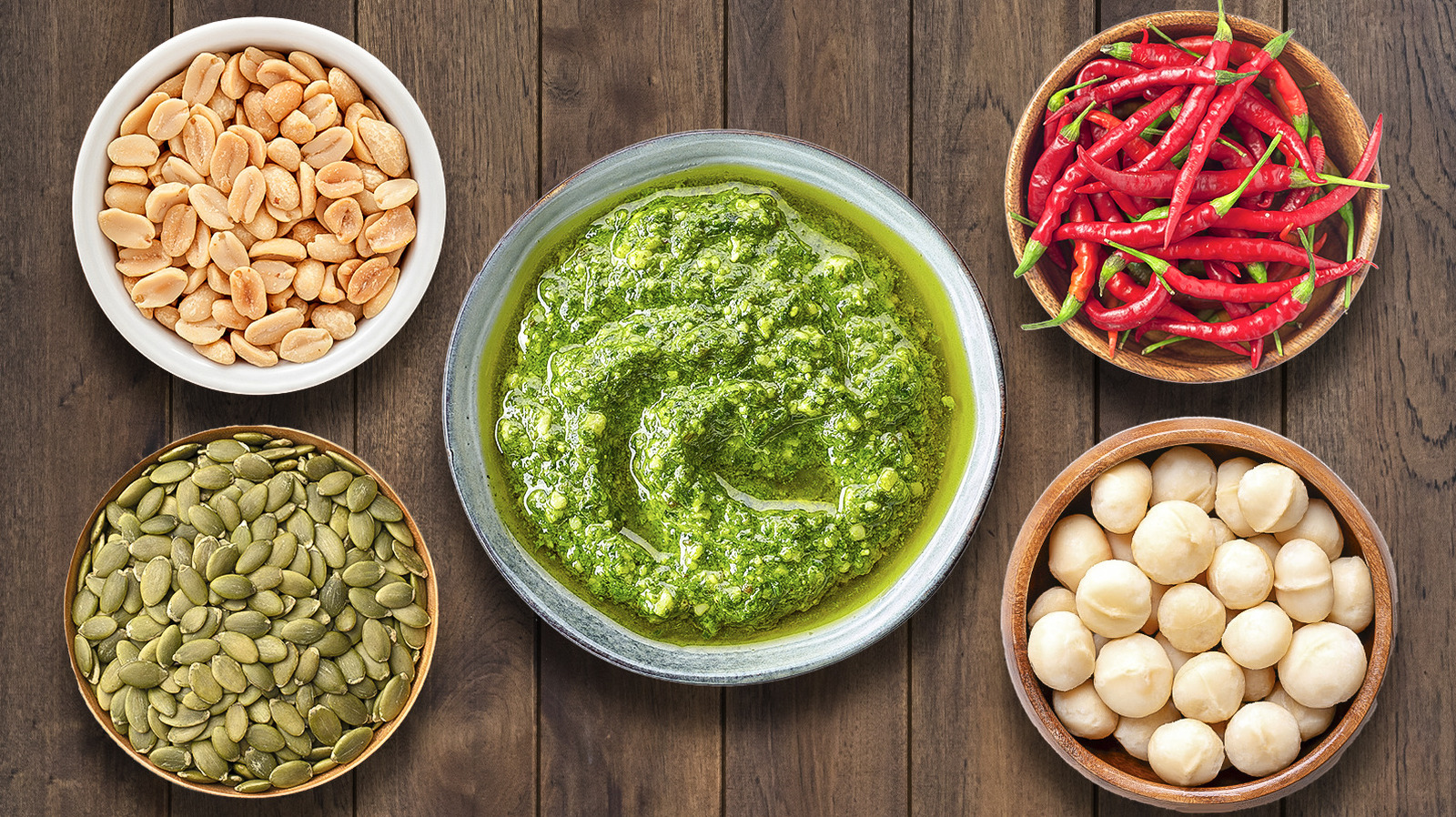If you want the most delicious, tastiest pesto possible, it’s best to make pesto yourself. We get it, though. Store-bought pesto can come in handy when you need to make a quick dinner, and the idea of doing anything other than boiling pasta and opening a jar of sauce seems impossible. If you’ve never made pesto before, it may sound intimidating, but it couldn’t be any easier: Just throw all of your ingredients in a food processor, pulse it a few times, and you’ve suddenly got homemade, bright and fresh pesto that’s ready to enjoy with a variety of foods.
What matters, though, is the kind of ingredients you add to the mix. Of course, classic pesto recipes abound, but you don’t always have to play by the rules to make a delicious sauce. Pesto may be one of the most versatile sauces around, allowing you to swap in different ingredients and flavors as you see fit. That’s why we’ve created this list of some unexpected ingredients you can add to your pesto to switch up the flavor — and to make things more interesting in the process. From alternative greens to nuts to fat sources, these ingredients will give your pesto the twist you never knew you needed.
Broccoli
Take a look at any basic pesto recipe, and you’ll notice that it probably calls for basil. That’s because it’s the staple green used in the dish, known for its fragrant, floral flavor profile; basil makes for an immensely tasty sauce, with mild and bold balance. But sticking to basil and basil alone is a big mistake if you want to change your pesto. One less conventional green that we love adding to our pesto is broccoli. Not only does incorporating broccoli into your pesto help you get more vegetables into your diet, it also gives the sauce a tinge of bitterness to make it more complex and interesting.
For the best results, you’ll want to blanch your broccoli ahead of time. This makes it easier to break down in the food processor and also helps to temper the pronounced bitterness. Cook the broccoli for around 30 seconds before placing it into an ice bath, and then it’s ready to incorporate into your pesto. With the added volume of broccoli, you don’t need as much basil. Play around with ratios to find what tastes best to you.
Roasted red peppers
When you’re looking for a pesto upgrade that packs a lot of unexpected flavor in the sauce, turn to roasted red peppers. Is this a traditional add-in for pesto? Not exactly. But it works, especially if you want to temper the intensity of all of that bold basil. By adding roasted red peppers into the mix, you’re providing the sauce with extra color, of course, along with a lovely sweetness that plays nicely with the acidity of the lemon juice. Additionally, roasted red peppers can give the sauce just a hint of smokiness, which takes the flavor profile of the sauce to a whole new level.
We like using jarred roasted red peppers, as they cut down on the prep time. However, you can also roast your peppers from scratch if you don’t mind spending some time at the grill. Just make sure not to char your red peppers too much, or you’ll be left with a burnt, unpleasant flavor in the sauce.
Pumpkin seeds
Although herbs may seem like they’re playing the starring role in any given pesto recipe, it’s actually the nuts that are providing the backbone of this sauce. Traditional pesto recipes call for pine nuts, which have a uniquely creamy texture that works well with a variety of herbs. However, pine nuts can be quite expensive, and they may not add as much flavor as some other types of nuts or seeds can. That’s why we love adding pumpkin seeds to our pesto. Not only are they quite a bit cheaper than pine nuts, but they also offer a rich pop of savory flavor that pine nuts just don’t have. They have a distinctly squash-like note to them that’s highlighted when they’re roasted, which is what we suggest doing before you add them into your food processor to make pumpkin seed pesto.
Using pumpkin seeds instead of pine nuts still lends a beautifully creamy texture to the sauce, but it gives it a more complex flavor, since they’re more pronounced than pine nuts. You can always use both pine nuts and pumpkin seeds in your pesto — just make sure you’re not doubling up on the nuts in your recipe.
Chervil
You can use nearly any herb in pesto, from parsley to cilantro and beyond. But one herb that might not come to mind is chervil. Admittedly, you can’t find chervil everywhere, but if you have access to it at a local grocery store or market, you should snag some the next time you want to make pesto. Chervil’s flavor is somewhat similar to parsley, although it also has a licorice-like note that’s conspicuously absent from other herby greens. This added complexity makes for a pesto unlike you’ve ever tasted before — and one that you’ll want to slather on pasta, bread, and so much more.
Like any of the greens mentioned on this list, you can decide to use chervil exclusively or combine it with basil (or other herbs) to create a more unique, interesting flavor. Who knows? You may find that you like the chervil-packed pesto better than a basil-based pesto.
Dandelion greens
If you’re a salad lover and you haven’t tried dandelion greens yet, what are you even doing? This is a leafy green that’s worth trying, whether you use it as a base for a salad or — if you’re like us — you incorporate it into a pesto recipe. These greens have a sharp bitterness, which makes them a marked departure from the flavor of basil. However, we love that sharpness, since it gives the finished sauce an extra layer of deliciousness to contend with. There’s almost a peppery note to the greens, with no actual peppers needed.
Love that intense, peppery flavor? In that case, go all in on the dandelion greens, omitting the basil that you’d normally use in its place. However, if you’re still new to the bitterness that dandelion greens can present in a dish, you may want to replace half of the basil with dandelion instead, so the two types of greens can mingle and mellow each other out. Either way, you’re in for a treat when it comes to your very own homemade dandelion green pesto.
Macadamia nuts
Out of all the nuts in the world, macadamia nuts might just be the most delicious. Good-quality macadamia nuts are unbelievably creamy, with a richness you can’t just get from, say, peanuts or almonds. In fact, this intense creaminess is somewhat reminiscent of pine nuts, which have a somewhat similar texture. Therefore, it only makes sense that you could easily swap out pine nuts for macadamia nuts and yield a similarly delicious finished sauce.
Unless the macadamia nuts you’re using are already toasted, you’ll want to toast them yourself, which helps bring out a more intensely nutty flavor along with some extra sweetness. Then, add them to the mixture of pesto ingredients that are already in your food processor and pulse away. Because macadamia nuts have a pretty mild flavor profile, they shouldn’t clash with any other ingredients you include in the mix, even if you choose to use some of the less-conventional ingredient suggestions on this list.
Avocado
Every pesto recipe depends largely on a source of fat, such as pine nuts, Parmesan cheese, and, most importantly, olive oil. With its savory, bold, bitter, and sometimes slightly spicy flavor, olive oil works exceptionally well for pesto. However, it’s not the only source of fat you can use to give your pesto the richness and creaminess it needs to achieve maximal deliciousness. One interesting fatty ingredient you can incorporate into the mix is avocado.
Diehard pesto traditionalists may scoff at this suggestion, but hear us out: Despite a mild, vegetal flavor, avocado tends not to taste like very much at all. This makes it an excellent replacement for other sources of fat, since that neutrality allows the herbs and nuts to shine. At the same time, avocado delivers an ultra-creamy texture, which can make a pesto sauce feel even more luscious with every bite. Just make sure you’re using a well-ripened avocado for the richest results.
Peanuts
Pine nuts are rather neutral in flavor and have a creaminess that contributes to the rich texture of classic pesto. Therefore, you may not consider peanuts to be an adequate nut replacement for the sauce, but it works. That being said, you’re only going to want to make the swap if you like the flavor of peanuts in the first place. That’s because peanuts have quite a strong and distinct flavor, and if you don’t like that flavor, then you may find that it overpowers the other ingredients in the mix.
If you do like peanuts, though, you’re in for a real delight the first time you make peanut pesto. Roast your own peanuts fresh or use the pre-roasted variety straight out of the jar. If you choose the latter option, though, just keep in mind that you’ll want to watch how much salt the peanuts you’re using already contain and adjust the salt in your recipe accordingly. Once you pulse those ingredients together in your food processor, you’ll notice how rich, flavorful, and unabashedly nutty this recipe is. If it’s too nutty for your taste, use half pine nuts, half peanuts for a hybrid sauce that offers just a hint of that intense, peanut-y flavor.
Chives
Calling all onion lovers! If you wish standard pesto packed more of a punch, then you’re probably going to love chive pesto. Instead of offering a more floral flavor profile, which you’ll find in classic basil pesto, chives will give your condiment a strong, bold, and sharp flavor. At the same time, chives are relatively mild compared to straight-up onions, which means the other ingredients you use aren’t going to be overpowered by the useful herb. There’s a nice balance between that sharpness and the fatty element you’ll add to the sauce, which rounds out the flavor and gives the pesto the harmony it needs to taste its best.
Again, it’s possible to add both chives and basil to your pesto, but you should make sure that you keep the ratios with the other ingredients the same. This will result in a milder pesto that’s not quite so onion-y for those who are looking for a less punchy sauce. If you ask us, though, pure chive pesto may just be the best sauce you could ever spread on anything.
Ramp tops
If you love spring onions, chives, and garlic, then congratulations, you’re a prime candidate for ramp top pesto. Ramps are a type of allium that is only available for a short time in the spring. They can be difficult to source, but if you can get your hands on them, they’re absolutely worth transforming into a springtime pesto sauce. Take a look at a ramp, and you’ll notice a white base near the root that looks similar to a spring onion. The top of the ramp, though, is a green leaf, and that’s what you’ll be using to make your pesto. This ingredient tastes somewhat like garlic, although with a milder, less punchy flavor to give your pesto the twist you’re craving.
If you want more intensity in your ramp pesto, you can try using the bulb, or bottom, of the ramp as well. However, we like to save that portion to use it as a flavorful addition to whatever dish we’re making to go with the pesto in the first place, like a ramp pesto pasta.
Lime
Many traditional basil pesto recipes call for lemon, which plays an extremely important role in the sauce. This ingredient cuts through all that fat — of which there is generally a lot, considering the inclusion of both pine nuts and olive oil — and gives the sauce a citrusy brightness. The lemon makes your mouth water when you get a whiff of particularly garlicky, particularly lemony pesto, and you may think that it’s an impossible ingredient to replace.
If you think this way, though, you’re wrong. In reality, lemon is replaceable, particularly when you happen to have a lime on hand. Like lemons, limes can give your pesto that bright acidity that you need to balance the sauce. However, limes have a more intense acidity and a sharper flavor profile. We think this flavor works especially well if you’re making cilantro pesto, but it can work with a variety of herbs and greens. So, no, there’s no need to make a special run to the grocery store just to get a lemon for your pesto when you already have a lime on hand. You might actually find that you enjoy this combo even more than the original.
Radish tops
These days, groceries are quite expensive. And if you care about getting the most bang for your buck, try to create as little food waste as possible. After all, throwing away perfectly good food is literally like throwing money in the trash, which most of us would like to avoid. Therefore, it’s always a good idea to figure out how to use produce scraps in the kitchen. One of our favorite ways to reduce waste when it comes to radishes is to use the tops as well as the root veggies themselves. Radish tops have a relatively mild albeit somewhat sharp, peppery flavor that can work well in a variety of contexts, but we especially like it as a swap for basil in a pesto recipe.
Make sure your radish tops are well-cleaned, then throw them into your food processor along with the other ingredients you’re including in the mix. Once you combine all those ingredients, you’re left with a slightly peppery, fresh, and green-tasting pesto that rivals even the best basil versions.
Watercress
Watercress is often used as a topping for sandwiches, but you shouldn’t limit its use to sandwiches alone. This ultra-flavorful, super-peppery ingredient can be incorporated into pesto as well. Of course, this may not be the best option if you’re not a fan of strong flavors, as watercress is quite pungent. For those who like that boldness, though, these greens give basic pesto a much-needed kick.
If it’s your first time incorporating watercress into your pesto, it may be best to combine it with a bit of basil so that the intense flavor doesn’t overwhelm your palate. This creates a milder sauce that’s more interesting than a classic recipe will offer. When you’re ready to embrace everything watercress is about, though, you can replace the basil with it completely. Once you taste how good this green sauce can be, you’ll never settle for basic, boring pesto again.





